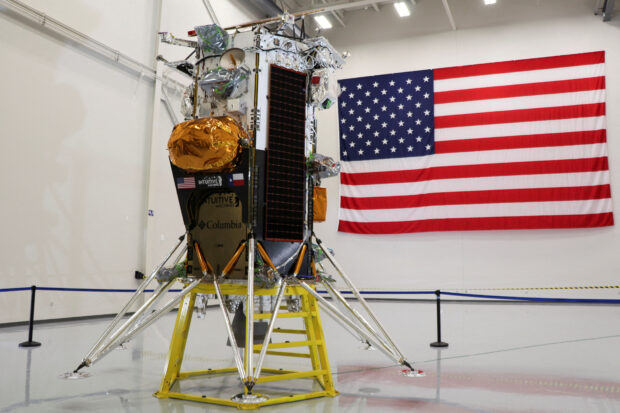Launch of private US moon lander postponed by technical glitch

The Nova-C lunar lander designed by aerospace company Intuitive Machines is displayed at the company’s headquarters in Houston, Texas, U.S., October 3, 2023. REUTERS FILE PHOTO
CAPE CANAVERAL, Florida — The planned launch of a robotic moon lander built by Houston-based aerospace company Intuitive Machines was called off less than two hours before Wednesday’s liftoff time and postponed for at least a day, launch contractor SpaceX said on Tuesday night.
SpaceX, the private rocket and satellite company founded by billionaire Elon Musk, said on the social media platform X that the launch team was “standing down from tonight’s attempt” because of irregular methane temperatures before loading.
The precise function of the methane and its implications for the proper function of the Falcon 9 rocket were not immediately explained. The rocket’s Merlin engines run on kerosene and liquid oxygen.
READ: Moon landing try by US firm seems doomed after ‘critical’ fuel leak
The decision to scrub the Intuitive Machines flight, which had been set for liftoff at 12:57 a.m. EST on Wednesday from NASA’s Kennedy Space Center at Cape Canaveral, Florida, came about 75 minutes before launch time.
SpaceX said it would aim for the next launch opportunity for the uncrewed mission, which is slated for 1:05 a.m. EST on Thursday.
Intuitive Machines’ Nova-C lander, dubbed Odysseus, remains poised atop the Falcon 9 rocket for a mission aimed at conducting the first U.S. lunar touchdown since the last Apollo moon mission a half century ago, and the first by a privately owned vehicle.
The feat also would mark the first journey to the lunar surface under NASA’s Artemis moon program, as the United States races to return astronauts to Earth’s natural satellite before China lands its own crewed spacecraft there.
The launch comes a month after the lunar lander of another private firm, Astrobotic Technology, suffered a propulsion system leak on its way to the moon shortly after being placed in orbit on Jan. 8 by a United Launch Alliance (ULA) Vulcan rocket making its debut flight.
READ: Moon lander from US firm launches to space aboard Vulcan rocket
The failure of Astrobotic’s Peregrine lander, which was also on a NASA mission, marked the third time a private company had been unable to achieve a “soft landing” on the lunar surface, following ill-fated efforts by companies from Israel and Japan.
Those mishaps illustrate the risks NASA faces in leaning more heavily on the commercial sector than it had in the past to realize its spaceflight goals.
The latest IM-1 flight is considered a Intuitive Machines mission, thought is carrying six NASA payloads of instruments designed to gather data about the lunar environment ahead of a NASA Artemis mission to return astronauts to the moon for the first time since 1972.
If the four-legged Odysseus lander gets off the ground this week, plans call for it to reach its destination on Feb. 22 for a landing at crater Malapert A near the moon’s south pole.